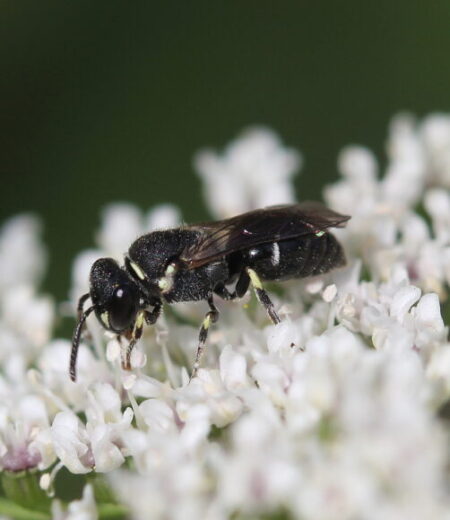This story first appeared in PA Local, a weekly newsletter by Spotlight PA taking a fresh, positive look at the incredible people, beautiful places, and delicious food of Pennsylvania. Sign up for free here.
By Stephen Caruso | Spotlight PA

Discovering bees requires patience, a discerning eye, and lots of tools.
Over 16 months, Kevin Thomas, a participant in a citizen science project by Penn State, caught 400 assorted bees in his rural backyard outside of Erie. His implements included brightly colored traps and a mesh net.
“When I’m netting, I’m looking for the odd bee,” he told PA Local.
The retired registered nurse netted a very odd one, he learned months after drying the tiny insect, fluffing up the hairs that pollen sticks to, separating the fore and hind wings crucial to identification, and sending it off to Penn State mounted on a foam block.
The special specimen was Sphecodes davisii, also known as Davis’ cuckoo sweat bee. Thomas’ was the first documented in the state.
“Honestly, it feels like it validates all the effort that you put into it,” he said of the discovery.
Thomas was among 26 trained volunteers — mostly master gardeners — from across the commonwealth involved in the Penn State study, whose results were recently published in the Annals of the Entomological Society of America. The collection effort, supplemented by photos submitted in the app iNaturalist, resulted in eight bee species being recorded in Pennsylvania for the first time.
The study sought to both expand the knowledge of bee biodiversity around the state and compare methods of monitoring the insects, which can range from crowd-sourcing photographs to catching, killing, and preserving them for study.
Five of the eight newly discovered bees were native to North America and three were nonnative, introduced from other continents.
That so many bee species were not documented until now is not surprising to scientists. Wildlife enthusiasts don’t catalog bees as readily as they do birds and game animals like white-tailed deer, so documentation of the bee species buzzing around the state through the centuries has been scant.
The new sightings bring the number of bee species recorded in the state to 437, said Nash Turley, a postdoctoral scholar at Penn State and lead author of the study. A few dozen of those species are nonnative; honeybees, for instance, were brought by European colonists centuries ago to provide a source of wax and sugar.
Interest in the livelihoods of bees has escalated since the 2006 discovery of a phenomenon known as colony collapse disorder that devastated the nation’s honeybee hives and threatened the pollination of the nation’s crops.
Since then, studies have shown other North American bee populations declining both in number and variety.
The Penn State study continued that work and also delved into the public debate over whether it is necessary to collect and kill bees for research given the arrival of crowd-sourced programs such as iNaturalist.

The collection team of trained volunteers killed more than 9,000 bees during the study, which ran from August 2021 to December 2022. The insects were then mounted and placed in storage, leaving them available for future research.
During the same period, 2,233 people sent photos of bees in Pennsylvania to iNaturalist, resulting in 6,809 observations.
Turley said the collection method is not intentionally callous. “We do take it seriously that we are killing animals that we like and are cool and everything.”
Saving collected specimens in perpetuity has scientific advantages down the line, he noted. For example, DNA can be extracted from bees to see how they are evolving with climate change.
And while 9,000 bees is a high number, they came from all over the state and local populations were not affected by the losses, Turley maintained. “The amount of bees we kill across the whole state is a fraction of bees that are killed along one strip of road [by vehicles].”
As for comparing the two methods for monitoring bees, the study found that trained volunteers working in the field identified more than twice as many species as iNaturalist users. Some 154 species were found only by the master gardener collectors.
One reason for the discrepancy is that many members of the general public tend to notice only colorful, larger, or slower-flying bees. “Most do not realize the vast majority of bees are small and not very fuzzy. A lot of people don’t recognize bees as bees,” said Turley.
In addition, many iNaturalist reports came from urban and suburban areas, Turley said. Such areas provide fewer habitats for bees, thus less species were found there.
In the burgeoning effort to learn more about bees and their pivotal role in biodiversity and food security, there is a need for both types of bee monitoring, he argued.
Meanwhile, study participant Tracy Snyder of Chambersburg is still buzzing about her first-in-the-state discovery of Heriades truncorum, a tiny black bee.
“I couldn’t believe it and having it be in my backyard was a wondrous thing. You have no idea what is just outside your back door. The world is not really a big place,” she said.
The new finds, and where in the state they were captured, are as follows:
Andrena duplicata (mining bee), a small native bee that favors sunflowers and goldenrods, found in the Pittsburgh area. There are only 27 other recordings of the species in the world.
Nomada banski (Bank’s nomad bee), a native parasitic bee known for gathering pollen by stealing it from other bees. It was collected in Clarion County.
Sphecodes johnsonii (sweat bee), a native parasitic bee. Both this bee and Nomada banski were found by the volunteer Kay John in her yard.
Hylaeus punctatus (punctate masked bee), a tiny black bee native to Europe. It was photographed for iNaturalist in the Philadelphia area.
Heriades truncorum (large-headed armored-resin bee), a nonnative tiny black bee. It was collected in Tracy Snyder’s yard in Franklin County.
Megachile xylocopoides (carpenter mimic leafcutter bee), a large native bee found near Philadelphia. Originally from the South, it appears to be migrating north with the aid of climate change.
Sphecodes davisii (cuckoo sweat bee), a member of the sweat bee family, which is attracted to perspiration. It was found in a yard near Erie.
Chelostoma campanularum (harebell carpenter bee), a tiny black bee that is not native to the United States. It favors bellflowers and sheep’s bit to gather pollen, and was found in Blair County.
BEFORE YOU GO… If you learned something from this article, pay it forward and contribute to Spotlight PA at spotlightpa.org/donate. Spotlight PA is funded by foundations and readers like you who are committed to accountability journalism that gets results.
Advertisement

Convenient Legal Access to High Quality Cannabis Just A Few Minutes Away!









